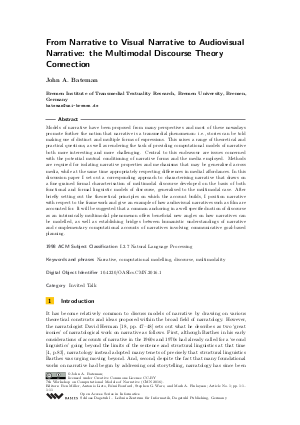From Narrative to Visual Narrative to Audiovisual Narrative: the Multimodal Discourse Theory Connection (Invited Talk)
Author John A. Bateman
-
Part of:
Volume:
7th Workshop on Computational Models of Narrative (CMN 2016)
Part of: Series: Open Access Series in Informatics (OASIcs) - License:
 Creative Commons Attribution 3.0 Unported license
Creative Commons Attribution 3.0 Unported license
- Publication Date: 2016-10-25
File

PDF
OASIcs.CMN.2016.1.pdf
- Filesize: 5.83 MB
- 11 pages
Document Identifiers
Subject Classification
Keywords
- Narrative
- computational modelling
- discourse
- multimodality
Metrics
- Access Statistics
-
Total Accesses (updated on a weekly basis)
0Document
0Metadata
Abstract
Models of narrative have been proposed from many perspectives and most of these nowadays promote further the notion that narrative is a transmedial phenomenon: i.e., stories can be told making use of distinct and multiple forms of expressions. This raises a range of theoretical and practical questions, as well as rendering the task of providing computational models of narrative both more interesting and more challenging. Central to this endeavour are issues concerned with the potential mutual conditioning of narrative forms and the media employed. Methods are required for isolating narrative properties and mechanisms that may be generalised across media, while at the same time appropriately respecting differences in medial affordances. In this discussion paper I set out a corresponding approach to characterising narrative that draws on a fine-grained formal characterisation of multimodal discourse developed on the basis of both functional and formal linguistic models of discourse, generalised to the multimodal case. After briefly setting out the theoretical principles on which the account builds, I position narrative with respect to the framework and give an example of how audiovisual narratives such as film are accounted for. It will be suggested that a common anchoring in a well specified notion of discourse as an intrinsically multimodal phenomenon offers beneficial new angles on how narratives can be modelled, as well as establishing bridges between humanistic understandings of narrative and complementary computational accounts of narratives involving communicative goal-based planning.
Cite As Get BibTex
John A. Bateman. From Narrative to Visual Narrative to Audiovisual Narrative: the Multimodal Discourse Theory Connection (Invited Talk). In 7th Workshop on Computational Models of Narrative (CMN 2016). Open Access Series in Informatics (OASIcs), Volume 53, pp. 1:1-1:11, Schloss Dagstuhl – Leibniz-Zentrum für Informatik (2016)
https://doi.org/10.4230/OASIcs.CMN.2016.1
BibTex
@InProceedings{bateman:OASIcs.CMN.2016.1,
author = {Bateman, John A.},
title = {{From Narrative to Visual Narrative to Audiovisual Narrative: the Multimodal Discourse Theory Connection}},
booktitle = {7th Workshop on Computational Models of Narrative (CMN 2016)},
pages = {1:1--1:11},
series = {Open Access Series in Informatics (OASIcs)},
ISBN = {978-3-95977-020-0},
ISSN = {2190-6807},
year = {2016},
volume = {53},
editor = {Miller, Ben and Lieto, Antonio and Ronfard, R\'{e}mi and Ware, Stephen G. and Finlayson, Mark A.},
publisher = {Schloss Dagstuhl -- Leibniz-Zentrum f{\"u}r Informatik},
address = {Dagstuhl, Germany},
URL = {https://drops.dagstuhl.de/entities/document/10.4230/OASIcs.CMN.2016.1},
URN = {urn:nbn:de:0030-drops-67028},
doi = {10.4230/OASIcs.CMN.2016.1},
annote = {Keywords: Narrative, computational modelling, discourse, multimodality}
}
